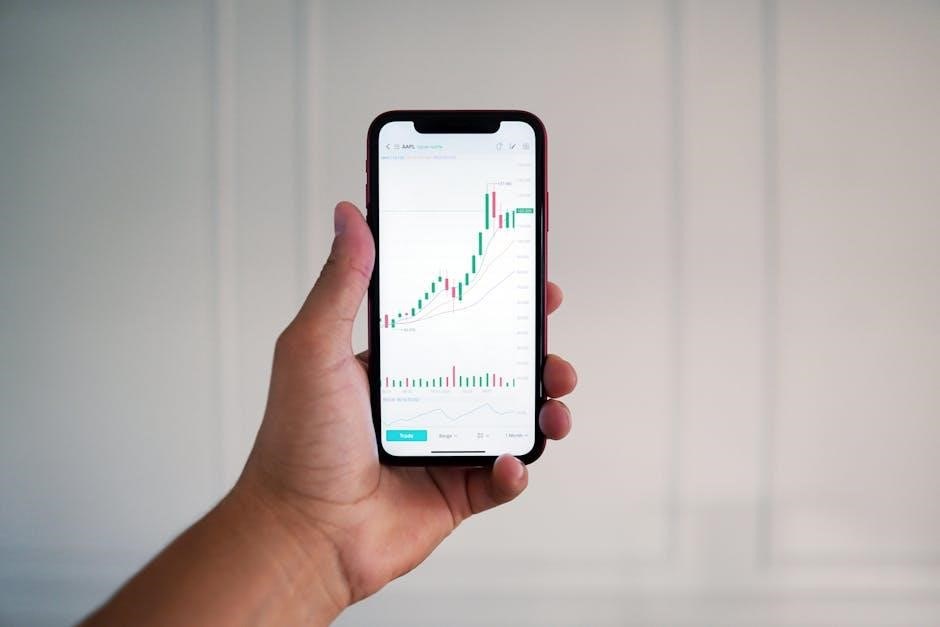This guide simplifies complex options trading concepts, making them accessible to all investors. It offers practical strategies to help unlucky traders achieve consistent growth and avoid common pitfalls.
Understanding the Challenges Faced by Unlucky Investors
Unlucky investors often struggle with emotional and cognitive pitfalls, such as overtrading, chasing losses, and relying on intuition over data. Many lack a deep understanding of volatility, the Greeks, and probability, leading to poor decision-making. Fear and greed frequently cloud judgment, causing impulsive trades. Additionally, unrealistic expectations and a lack of discipline exacerbate losses. These challenges highlight the need for education and strategy to shift from luck-based outcomes to skill-driven results in options trading.
Why Options Trading Can Be Particularly Risky for Novices
Options trading is inherently complex, with factors like volatility, time decay, and the Greeks (Delta, Gamma, Theta) impacting outcomes. Novices often lack the knowledge to navigate these dynamics, leading to costly mistakes. The potential for significant losses, especially when using leverage, can overwhelm inexperienced traders. Additionally, emotional decision-making and a lack of risk management strategies exacerbate risks. Without a solid understanding of probability and market behavior, novices may repeatedly fall into pitfalls, making options trading a high-risk endeavor for those new to the field.

The Basics of Options Trading for Unlucky Investors
Options trading involves contracts giving the right to buy or sell assets at set prices. Understanding calls, puts, and key terms is essential for avoiding common mistakes.
What Are Options and How Do They Work?
Options are contracts granting the right, but not the obligation, to buy or sell an asset at a specified price (strike price) before a certain date (expiration). A call option allows buying, while a put option allows selling. Key components include the strike price, expiration date, and premium (cost of the option). Options are derivatives, meaning their value derives from an underlying asset, such as stocks or commodities. They offer flexibility for speculation or hedging but require careful understanding to avoid costly mistakes, especially for unlucky investors.
Key Terms Every Investor Should Know
Understanding key terms is essential for mastering options trading. A strike price is the price at which an asset can be bought or sold. The expiration date is when the option becomes invalid. A call option gives the right to buy, while a put option allows selling. The premium is the cost of the option. Intrinsic value is the profit if exercised now, while extrinsic value reflects time and volatility. Delta, Gamma, and Theta measure risk. Volatility impacts pricing, making these terms vital for informed trading decisions.
The Difference Between Calls and Puts
A call option gives the holder the right to buy an underlying asset at a specified price (strike price) before expiration, ideally when the price rises. Conversely, a put option grants the right to sell the asset at the strike price, benefiting if the price drops. Calls are typically bought by bullish investors, while puts are used by bearish ones or for hedging. Both tools allow traders to speculate or protect against price movements, but their outcomes depend on market direction and timing. Understanding this distinction is crucial for effective options trading strategies.

Common Mistakes Unlucky Investors Make in Options Trading
Unlucky investors often fall into overtrading, ignoring the Greeks, and misunderstanding volatility. These errors can amplify losses, highlighting the need for disciplined strategies and education.
Overtrading and Chasing Losses
Overtrading is a common pitfall for unlucky investors, driven by emotional decisions rather than strategic planning. Chasing losses in an attempt to recoup failed trades often exacerbates financial damage. This behavior stems from fear and greed, clouding judgment and leading to poor risk management. Without a disciplined approach, investors may overleverage their accounts, ignoring market realities. Recognizing these patterns is crucial for breaking the cycle and adopting a more controlled trading mindset.
Ignoring the Greeks (Delta, Gamma, Theta)
Ignoring the Greeks—Delta, Gamma, and Theta—is a critical mistake in options trading. Delta measures the option’s price sensitivity to the underlying asset, while Gamma measures how Delta changes. Theta reflects time decay, eroding option value daily. Overlooking these metrics can lead to significant losses, as traders fail to anticipate price movements or account for time-related risks. Understanding the Greeks is essential for managing positions effectively and making informed decisions. Neglecting them often results in unintended exposure and poor outcomes for unlucky investors.
Not Understanding Volatility and Its Impact
Volatility is a key driver of options pricing, yet many unlucky investors fail to grasp its significance. High volatility increases option premiums, while low volatility reduces them. Ignoring volatility leads to poor trade execution, as it directly impacts potential profits and losses. Without understanding how volatility affects pricing models, investors often overpay for options or misjudge market movements. This oversight can result in substantial losses, especially for those already struggling with unlucky trading outcomes. Recognizing and adapting to volatility is crucial for improving trading decisions and avoiding costly mistakes.

Risk Management Strategies for Unlucky Investors
Effective risk management is essential for unlucky investors to balance potential gains and losses. Strategies like position sizing, stop-loss orders, and diversification help mitigate risks and improve trading outcomes.
The Importance of Position Sizing
Position sizing is a critical risk management tool for unlucky investors, helping them allocate capital wisely across trades. By determining the optimal amount to invest in each position, traders can avoid overexposure and balance portfolio risk. This strategy ensures that no single trade disproportionately impacts overall performance, safeguarding against significant losses. Proper position sizing aligns with risk tolerance and investment goals, fostering disciplined trading habits. It allows investors to manage volatility and uncertainty effectively, even when luck isn’t on their side.
How to Set Stop-Loss Orders Effectively
Setting stop-loss orders is a vital risk management technique for unlucky investors to limit potential losses. A stop-loss order automatically sells an option or stock when it reaches a predetermined price, protecting against significant declines. Investors should base stop-loss levels on volatility, support/resistance levels, or statistical models to avoid unnecessary exits. Avoid setting stops too tight, as market fluctuations can trigger them prematurely. Regularly review and adjust stop-loss levels to align with changing market conditions and ensure they remain effective in managing risk.
Diversification in Options Trading
Diversification is a critical strategy for unlucky investors to minimize risk in options trading. By spreading investments across various assets, industries, and expiration dates, traders reduce exposure to single-trade losses. Diversification helps balance high-risk and low-risk strategies, ensuring a more stable portfolio. It also prevents over-reliance on a single market sector, which can be particularly volatile. Unlucky investors should avoid concentrating their capital in one direction and instead allocate it across multiple strategies, such as calls, puts, and spreads, to create a balanced and resilient trading approach.

Understanding Probability and Statistics in Options Trading
Understanding probability and statistics is crucial in options trading, helping unlucky investors grasp how likelihoods influence decisions and statistical models predict price movements and risks.
Why Probability Matters in Options Trading
Probability is the foundation of options trading, as it helps investors assess the likelihood of price movements and make informed decisions. By understanding probability, traders can better manage risks, set realistic expectations, and avoid relying on luck. It enables them to evaluate potential outcomes, optimize strategies, and improve consistency. Without grasping probability, traders are more likely to make emotional or uninformed decisions, leading to unlucky outcomes. Probability provides a framework for analyzing volatility, implied odds, and expected returns, making it indispensable for successful options trading.
How to Read and Interpret Option Pricing Models
Option pricing models, such as the Black-Scholes model, provide a framework for determining the theoretical value of options. These models incorporate factors like volatility, time to expiration, and the underlying asset’s price to predict potential outcomes. By understanding how to read and interpret these models, traders can better assess option pricing, identify mispriced opportunities, and make data-driven decisions. This skill is crucial for minimizing reliance on luck and maximizing informed strategies in options trading.
The Role of Implied Volatility in Options Pricing
Implied volatility (IV) is a critical factor in options pricing, reflecting market expectations of future price fluctuations. It influences the theoretical value of options, with higher IV leading to higher option prices. Understanding IV helps traders gauge market sentiment and potential risks.
Traders should monitor IV changes, as they indicate shifting market perceptions. High IV suggests greater uncertainty, while low IV indicates stability. This insight is vital for making informed trading decisions and avoiding costly missteps in options markets.

Psychological Traps That Lead to Unlucky Outcomes
Psychological traps like fear and greed often lead to emotional decisions, causing unlucky outcomes for investors in options trading. These biases result in impulsive actions and poor risk management.
The Impact of Fear and Greed on Trading Decisions
Fear and greed are powerful emotional forces that significantly influence trading decisions, often leading to unlucky outcomes. Fear can drive impulsive actions, such as panic selling, while greed may push investors to take excessive risks. These emotions often cloud rational judgment, causing traders to deviate from their strategies. For instance, fear of missing out (FOMO) can lead to overtrading, while greed may result in holding losing positions too long. Understanding and managing these emotions is crucial for making objective, data-driven decisions and avoiding costly mistakes in options trading.
Cognitive Biases That Affect Investors
Cognitive biases often lead unlucky investors to make suboptimal trading decisions. Confirmation bias, for instance, causes traders to favor information that aligns with their existing beliefs, ignoring contradictory data. Anchoring bias leads to over-reliance on initial prices, even when market conditions change. Loss aversion, the fear of losses outweighing potential gains, often results in holding onto unprofitable trades too long. These biases collectively distort rational decision-making, making it crucial for investors to recognize and address them to improve their trading outcomes and avoid repetitive, costly mistakes in options trading.
How Emotional Decision-Making Can Lead to Losses
Emotional decision-making is a major pitfall for unlucky investors in options trading. Fear and greed often cloud judgment, leading to impulsive choices. For example, panic selling during market dips can lock in unnecessary losses, while chasing gains due to greed may result in overtrading. Anxiety and overconfidence also distort rational thinking, causing traders to deviate from their strategies. Recognizing these emotional patterns is crucial, as they frequently lead to poor outcomes. By acknowledging and managing emotions, investors can reduce impulsive errors and adopt more disciplined, data-driven approaches to trading.
Case Studies of Unlucky Investors and Their Mistakes
Real-life examples reveal common pitfalls, such as overtrading and ignoring volatility, offering valuable lessons for avoiding costly errors in options trading.
Real-Life Examples of Failed Options Trades
This section examines real-world scenarios where investors faced significant losses due to poor decision-making. For instance, one trader ignored position sizing rules, leading to a substantial loss from a single trade. Another misjudged volatility, resulting in expired worthless options. These examples highlight common pitfalls, such as overtrading and ignoring the Greeks, emphasizing the importance of education and disciplined strategies to avoid such outcomes in options trading.
Lessons Learned from Common Pitfalls
Analyzing failed trades reveals critical lessons for investors. Overtrading often leads to unnecessary risks, while ignoring volatility can result in significant losses. Poor position sizing exacerbates potential damages, emphasizing the need for disciplined strategies. Emotional decision-making, driven by fear or greed, frequently undermines logical choices. These mistakes highlight the importance of understanding the Greeks, managing risk, and adhering to well-defined plans. By learning from these errors, investors can refine their approaches, fostering resilience and improving long-term outcomes in options trading.
How to Avoid Repeating the Same Mistakes
To prevent recurring errors, investors should document trades and analyze losses to identify patterns. Regularly reviewing strategies and adjusting plans helps refine approaches. Setting clear risk parameters and sticking to disciplined execution minimizes impulsive decisions. Leveraging educational resources and seeking mentorship provides fresh insights. Implementing strict position sizing and diversification reduces exposure to single-trade risks. By fostering a growth mindset and embracing continuous learning, traders can evolve beyond past pitfalls, building a resilient and adaptive approach to options trading.

Rebuilding Your Portfolio After Losses
Assess risk tolerance, diversify investments, and implement strategies to recover losses. Focus on disciplined trading plans and gradual portfolio reconstruction to rebuild confidence and stability over time.
Steps to Recover from a Series of Unlucky Trades
Recovering from unlucky trades requires a systematic approach. First, analyze past trades to identify mistakes and refine your strategy. Next, set realistic goals and implement stop-loss orders to limit further losses. Finally, focus on rebuilding confidence by gradually reintroducing smaller, well-researched positions. Continuous learning and emotional discipline are key to regaining stability and long-term success in options trading. Avoid chasing losses and stay committed to your revised trading plan.
How to Reassess Your Risk Tolerance
To reassess your risk tolerance, start by reflecting on your past trades and how you responded to losses. Consider your comfort with volatility and potential downside. Adjust your position sizes and leverage to align with your risk appetite. Diversify your portfolio to avoid overexposure to risky assets. Validate these changes by testing them in simulations or small trades. Finally, ensure your emotional readiness to stick to your new risk parameters, as consistency is key to rebuilding trust in your trading decisions.
Creating a New Trading Plan After a Loss
After experiencing losses, it’s crucial to create a new trading plan tailored to your current situation. Start by defining clear, realistic goals and assessing your financial capacity for further risks. Analyze past trades to identify mistakes and refine your strategy. Simplify your approach, focusing on high-probability trades and incorporating risk management tools like stop-loss orders. Prioritize emotional discipline and consistency. Regularly review and adjust your plan to ensure alignment with your evolving risk tolerance and market conditions. A well-structured plan helps rebuild confidence and stability in your trading journey.

Advanced Strategies for Unlucky Investors
Explore probability-based trading, iron condors, and hedging techniques to minimize risks and maximize returns; These strategies help unlucky investors refine their approach and build resilience in volatile markets.
Probability-Based Trading Approaches
Probability-based trading focuses on using statistical models to predict market movements. By analyzing historical data and volatility, investors can assess the likelihood of an option expiring in or out of the money. This approach helps unlucky investors make data-driven decisions, reducing reliance on intuition. Techniques like probability cones and distribution analysis provide visual insights into potential price ranges. Understanding implied volatility is crucial, as it directly impacts option pricing. By focusing on high-probability trades, investors can minimize losses and build a more resilient portfolio over time. This method emphasizes consistency over luck.
Using Iron Condors and Other Neutral Strategies
Iron Condors are a popular neutral options strategy that profits from market stability. By selling and buying call and put options at different strike prices, investors create a range where they expect the underlying asset to stay. This approach reduces reliance on market direction, making it ideal for unlucky investors seeking consistent returns. Other neutral strategies, like calendars and butterflies, also focus on time decay and volatility without requiring significant price movement. These methods help diversify risk and generate income, offering a balanced approach for traders looking to minimize losses and build resilience.
How to Hedge Your Bets in Options Trading
Hedging in options trading involves combining positions to reduce risk exposure. Techniques like collars (buying puts and selling calls) or spreads (bull put spreads) can protect against significant losses. These strategies limit potential downside while still allowing upside potential. Hedging is particularly useful for unlucky investors, as it creates a safety net against unfavorable market movements. By balancing risk and reward, traders can avoid major setbacks and maintain portfolio stability. This disciplined approach helps manage emotional biases and ensures a more consistent trading experience over time.

Tax Implications and Regulations for Options Trading
Understanding tax laws is crucial for options traders to report income correctly. Familiarize yourself with specific regulations and avoid common pitfalls to prevent penalties.
Understanding Tax Laws for Options Traders
Options trading is subject to specific tax rules that traders must understand to avoid penalties. Short-term gains are taxed as ordinary income, while long-term gains may qualify for lower rates. The IRS considers options as securities, and profits are reported as capital gains. However, complex rules like the wash-sale rule can impact tax outcomes. Traders must accurately report all trades and maintain detailed records to ensure compliance. Proper tax planning and consultation with a tax professional can help mitigate risks and optimize financial outcomes in options trading.
How to Report Options Trading Income
Reporting options trading income requires careful documentation and adherence to IRS guidelines. Traders must report all profits and losses on IRS Form 8949 and Schedule D. Short-term gains (held less than a year) are taxed as ordinary income, while long-term gains qualify for reduced rates. The wash-sale rule may defer losses if a similar position is repurchased within 30 days. Accurate records of each trade, including dates and proceeds, are essential. Consulting a tax professional can help ensure compliance and optimize tax outcomes for options traders.
Regulatory Pitfalls to Avoid
Navigating the regulatory landscape is crucial for options traders. Failure to comply with IRS rules can lead to penalties. Key pitfalls include tax non-compliance, such as unreported income or incorrect filings. The wash-sale rule can defer losses if repurchasing similar securities within 30 days. Additionally, traders must avoid unauthorized trading practices, which can result in legal consequences. Staying informed about SEC and FINRA regulations is essential. Consulting with a tax or legal professional can help traders avoid these common regulatory missteps and ensure compliance with all applicable laws.

Final Tips for Unlucky Investors to Turn Their Luck Around
Adopt a disciplined approach, continuously learn from mistakes, and stay patient. Refine your strategy, set realistic goals, and avoid emotional decisions to transform your trading journey.
The Importance of Continuous Learning
Continuous learning is vital for unlucky investors to improve their trading outcomes. Educating oneself about options trading strategies, market trends, and risk management techniques helps avoid common pitfalls. Staying updated on financial news and analyzing past mistakes fosters better decision-making. Utilizing resources like books, online courses, and expert insights can enhance trading skills. By dedicating time to learning, investors can refine their approaches, adapt to market changes, and build a stronger foundation for long-term success in options trading.
Staying Disciplined in Your Trading Approach
Discipline is crucial for unlucky investors to transform their trading outcomes. Adhering to a well-defined trading plan helps avoid impulsive decisions driven by emotions. By sticking to predefined entry and exit criteria, investors can minimize losses and maximize gains. Discipline also involves managing risk through position sizing and stop-loss orders. Consistently following these practices builds resilience and prevents reckless behavior. Over time, discipline fosters a systematic approach, reducing reliance on luck and enhancing overall trading performance in the options market.
When to Walk Away and Reevaluate Your Strategy
Recognizing when to step back is vital for unlucky investors to avoid further losses. If experiencing consecutive losses or emotional trading, it’s time to reassess. Reevaluate your strategy by reviewing past trades, identifying mistakes, and adjusting your risk tolerance. A break allows clarity and prevents impulsive decisions. Use this pause to educate yourself on new techniques or consult resources like The Unlucky Investor’s Guide to Options Trading. Returning with a refreshed mindset and refined plan can lead to better outcomes and reduced reliance on luck in the markets.
Persistence and continuous learning are key. Discipline and strategy can shift luck. Use the guide’s insights to refine your approach and improve trading outcomes over time.
Summarizing Key Takeaways for Unlucky Investors
This guide emphasizes understanding options fundamentals, managing risks, and avoiding common pitfalls. Key lessons include the importance of position sizing, Stop-Loss orders, and diversification strategies. Emotional discipline is crucial to overcoming fear and greed. Probability and volatility play significant roles in trading decisions and must be understood thoroughly. Advanced techniques like Iron Condors and hedging can help mitigate losses. Continuous learning and adapting strategies are essential for long-term success, transforming unlucky outcomes into profitable opportunities through informed and disciplined approaches to options trading.
Encouragement to Keep Improving and Learning
Every unlucky trade is a lesson, and persistence is key to turning luck around. Embrace continuous learning, adapt strategies, and stay disciplined. Markets evolve, and so should your approach. Surround yourself with resources, mentors, and tools to refine your skills. Remember, success in options trading is a journey, not a destination. Stay committed, and over time, unlucky streaks will give way to informed, profitable decisions. Keep learning, growing, and believing in your ability to improve.